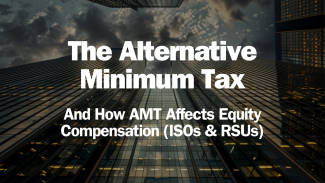
Case Study: The Alternative Minimum Tax (AMT) and Equity Compensation (ISOs & RSUs)
Bob and Julia both work for fictional tech companies.
Bob receives $100k worth of ISOs, and Julia gets $100k worth of RSUs.
Their situations are identical outside of their ISOs and RSUs—they have the same vesting schedules and company trajectory, and they even have Goldendoodles named Quinn.
Bob: The ISO Guy
Bob is granted ISOs worth $100,000 for $50,000.
Upon meeting the vesting criteria, he pays $50,000 out of pocket for the shares.
Let's assume the value of Bob's options increases to $150,000 over the vesting period.
Bob doesn't owe regular income tax when he exercises his ISOs, regardless of the bargain element (market value at exercise minus exercise price).
However, this $100,000 ($150,000 - $50,000) bargain element is subject to AMT.
To understand how this would be taxed under AMT, let's go through the steps:
- Add the Bargain Element to AMTI: Bob's Alternative Minimum Taxable Income (AMTI) will include this $100,000 bargain element. Remember, the actual AMT depends on his total income and deductions, which are subject to AMT rules, and our example assumes the bargain element is the only factor.
- Apply the AMT Exemption: Bob is single. For 2023, the AMT exemption amount for a single filer is $81,300. This exemption phases out at higher income levels.
- Assuming Bob's income (including the bargain element) is low enough not to trigger the phase-out, we subtract the exemption from his AMTI.
- $100,000 (Bargain Element)
- $81,300 (AMT Exemption)
- AMTI for AMT = $18,700
- Calculate the Tax: In 2023, the AMT rate for a single filer was 26% for income up to $206,100 and 28% for income above that. Since Bob's AMTI for AMT purposes is $18,700, he falls into the 26% bracket.
AMT = $18,700 * 26% = $4,862
So, Bob will owe the IRS $4,862 upon the exercise of his ISOs.
If Bob holds the stock for more than one year after exercising and two years after the grant date (qualifying disposition) and then sells the shares when they are worth $200,000, his profit of $150,000 (the $200,000 sale price minus the $50,000 he paid for them) is taxed as a long-term capital gain.
Let’s assume 15% long-term capital gains tax, so $22,500.
Bob has paid a total of $27,362 in taxes on his ISOs, keeping $172,638.
Julia: The RSU Gal
Julia is granted $100,000 worth of RSUs that vest over the same period as Bob's ISOs.
When Julia's RSUs vest and their value increases to $150,000, that amount is considered taxable ordinary income in the year of vesting, subject to federal, state, and payroll taxes.
Let’s assume she pays 30% in taxes—a rough estimation based on her federal income tax bracket and payroll taxes. She lives in a state without state income taxes.
She pays that 30% on the $150,000 value of the stock– or $45,00 in tax out of pocket.
If Julia holds the shares post-vesting and sells them one year later when they are worth $200,000, she pays long-term capital gains tax on the $50,000 increase (the $200,000 sale price minus the $150,000 value at vesting).
Let’s assume a long-term capital gains tax of 15%, so $7,500.
Julia has paid a total of $52,500 in taxes on her RSUs, keeping $147,500 of the RSU amount.
Conclusion: Bob Vs. Julia
Bob's total tax burden ($27,362) is lower than Julia's ($52,500), mainly due to the favorable tax treatment of ISOs, despite the AMT consideration.
Bob retains more after-tax proceeds ($172,638) compared to Julia ($147,500), illustrating how ISOs can be more tax-efficient than RSUs when the conditions for a qualifying disposition are met.
This comparison demonstrates the potential tax advantages of ISOs over RSUs, especially when the ISO holder can meet the requirements for a qualifying disposition and capitalize on lower long-term capital gains rates.
The AMT can complicate the situation for ISO holders, especially at higher bargain elements, deductions, and income levels, underscoring the importance of careful tax planning.
This example demonstrates how ISOs can receive favorable tax treatment if specific criteria are met– even with the AMT. But, let’s keep in mind ISOs and RSUs aren’t typically meant for a holistic 1:1 comparison, as the risk profile and timelines will vary per company.
